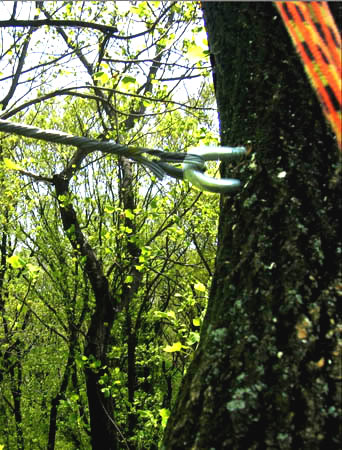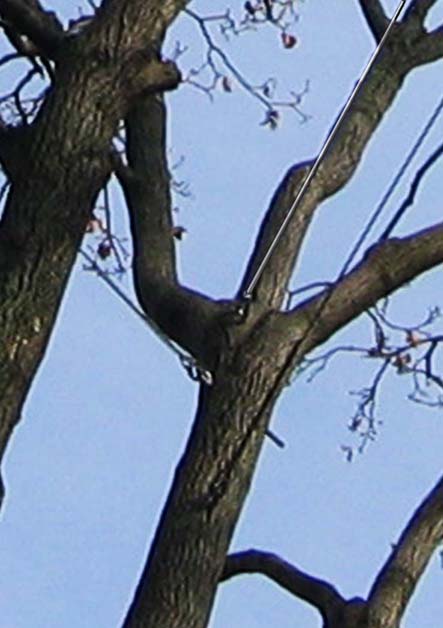Cabling is simply installing steel hardware and a guy or support cable between two stems, or between a stem and large branch where there is a structural defect at the branch union.

Cabling uses extra high strength (EHS) ¼” steel cable to stabilize a structural defect, normally in a mature tree. Most cables are used to correct one specific type of structural defect; called co-dominant stems with included bark (see photos). Trees growing with this defect are often otherwise perfectly healthy and structurally sound, but this one defect can cause catastrophic failure as up to one half of the tree can rip off from the trunk, leaving the remaining wound open to inevitably decay.
The good news is that a properly installed cable is often enough to completely ensure that the tree will not fail. Big, heavy leaning trees with lots of compaction built up in the included bark area are most at risk. These trees will invariably fail, if left uncorrected. Cabling may also be employed to protect a specimen tree or ensure the safety of valuable property under a big limb. When used to correct for included bark, cabling is crucial in preventing imminent catastrophe, whereas when used on specimen trees that do not have co-dominant stems with included bark, it is more of an insurance policy.
A lay person is not able to understand when a cable is required. This must be determined by an experienced arborist. Daniel has the scientific understanding, professional training, and hands-on experience to evaluate your trees, and install proper support cables when needed.
Daniel says: In the past 29 years of observing trees, I’ve noticed that the vast majority of cables (installed by other companies) are installed too low. Industry standards call for cables to be installed 2/3 of the way from the branch union or crotch to the tips. Most cables are installed far below the height called for in the ANSI industry guidelines. These low cables are improperly installed either from a lack of understanding by an untrained arborist that thinks cables should be put in larger diameter (and therefore lower) wood, or as a matter of convenience to the climber, who does not want to climb high enough to meet the 2/3 distance from the branch union to tips rule. If the tree has a height of 60’ from the branch union to the tips, then the cable should be installed at least 40’ above the branch union.
When I first started to do tree work, I thought it was important to put cables into thicker wood, thinking that thicker wood would hold better, that is a fairly common misperception with inexperienced arborist. There is no doubt with all the poorly trained arborist around, that this is one of the major reasons for improperly installed cables. The other reason is strictly convenience. When using a bucket truck, most companies will install the cable as high as the bucket will reach and no higher. And when climbing it is often very difficult for one climber to span the gap between the two co-dominant stems, at the proper height. Many climbers will simply take an easier route and install a low cable. We generally installs cables with 2 climbers making it far easier for each climber to install the cable at the proper height, as there is no need to make the swing between stems.
The industry standard of 2/3 the height is somewhat an arbitrary figure. I prefer to install the cables even higher, when practical. Understanding the principles of leverage, I realize just how important it is to install cables at a proper height. Cables tend to have an effective life span of approximately 15 years. In my experience, a properly installed cable will generally last at least 15 years. Improperly installed cables may not last through the next storm. Though I tend to charge a little more for cabling, the small additional cost is well worth the insurance of knowing you have a properly installed cable, which will ensure your safety and the longevity of your trees.



